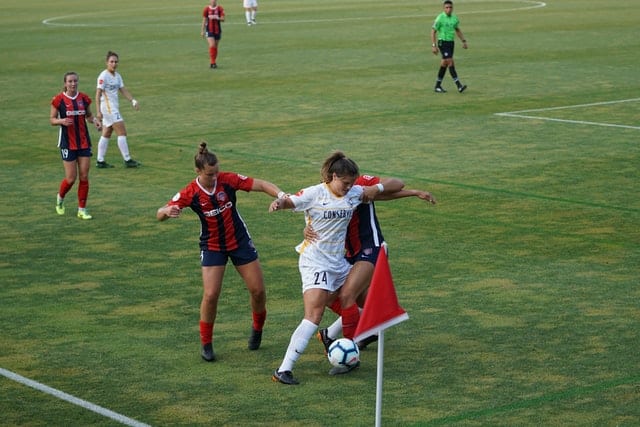In soccer, there are a few things that happen at least once almost every single soccer match no matter what, and one of these actions is tackling the ball.
Tackling the soccer ball during a soccer match is part of the game’s identity, and you’ll see a lot of defenders tackling the ball throughout a soccer match. But what exactly is a tackle in soccer?
A tackle in soccer is a defense mechanism where a defender attempts to grab the ball from their opponent through a one vs one encounter. To tackle the ball, a player usually either extends their foot to grab the ball from their opponent or slide towards them to take the ball away from them.
I have been watching soccer for more than 10 years, and I have seen thousands of tackles throughout these years. In this article, I’ll share with you the types of tackles in soccer along with many other information about these tackles.
But first, I need to answer a quick question for those who are completely new to soccer.
Are tackles allowed in soccer?
Tackles in soccer are allowed as long as the player performing the tackle hits the soccer ball instead of hitting their opponent.
If a soccer player tackles their opponent instead of tackling the ball, then they might get a yellow card or even a red card depending on the severity of the tackle.
However, most soccer players attempt to tackle the ball itself instead of tackling their opponent, and if they miss the ball somehow, then their opponent will most probably only get a foul.
As I have mentioned earlier, tackles are part of soccer’s identity and they are performed during almost every single match.
The number of successful tackles performed by a soccer player contributes to how good the player is. For example, here are the soccer players who have performed the most amount of tackles in the 2020/21 season of the Premier League.
If you don’t know that the Premier League is, it’s basically one of the best soccer leagues in the world. You can learn more about soccer leagues from our article here.
With that out of the way, let’s move on.
What are the types of tackles in soccer?
There are many ways in which a soccer player may attempt to tackle there opponent, but the most common ones are the following:
- Slide tackles
- Block tackles
- Poke tackles
- Shoulder tackles
Each of these tackles have their own use cases and you’ll most probably see most of these tackles in action during almost every single soccer game.
Here is more info about each and every one of these tackles.
What are slide tackles in soccer?
Slide tackles are one of the most impressive types of tackles in soccer. A slide tackle is when a player slides towards their opponent and takes the ball from them or kicks the ball away.
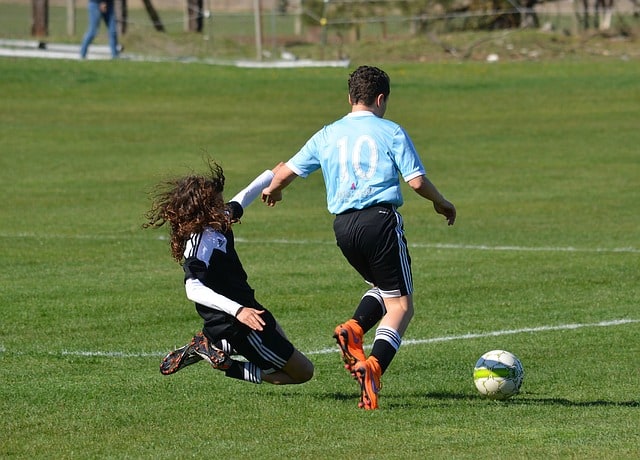
Slide tackles are heavily celebrated by soccer fans. If a defender was able to perform a slide tackle on the ball, then they’ll usually get some praise and claps from the audience.
Slide tackles are usually more risky than the other types of tackles though. When a defender slides towards their opponent who is running at a high speed, there’s a chance that they kick the opponent instead of kicking the ball and that might lead to an injury and possibly a yellow or a red card.
So if you are a soccer player, then use slide tackles with high caution and only when extremely necessary.
Slide tackles are usually performed by a defender when the opponent has already passed them and the only way to reach the ball is to slide towards it and steal it from the opponent.
Slide tackles are also very common on the sides of the soccer field. Usually, when a winger is running on the side of the field with full speed and is planning to cross the ball towards the penalty area of their opponent, then a defense player might attempt to slide tackle the winger and extract the ball from them before they do anything with it.
What are block tackles in soccer?
Block tackles are very common in soccer. A block tackle takes place when a defender confronts their opponent face to face and attempts to extend their leg to grab the ball from the opponent.
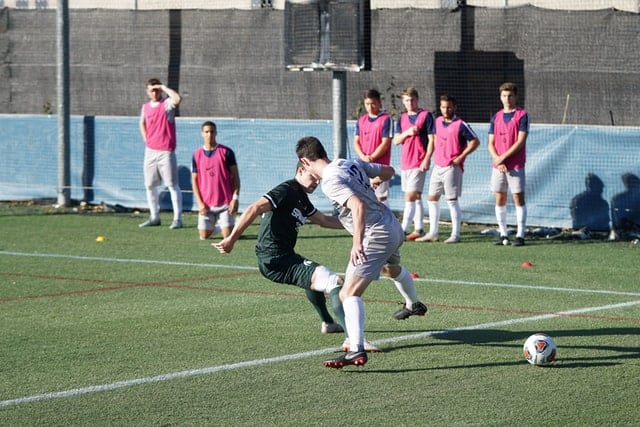
Block tackles are most commonly used against dribblers. If a defender’s opponent is trying to dribble past them, then the defender will attempt to perform a block tackle to take the ball from their opponent.
Block tackles are also important if the opponent team uses short and quick passes as their strategy (tiki-taka). For example, a defender might attempt to use a block tackle against their opponent the moment the opponent receives a short pass from their teammates.
What are poke tackles in soccer?
Poke tackles are the tackles that intend to kick the ball away from the opponent (i.e., poke the ball).
In other words, when you attempt a poke tackle, you don’t intend to take the ball for yourself, but you intend to just kick it away from your opponent.
Poke tackles are usually performed from the side of your opponent or from behind. The defender runs towards their opponent from the side and kicks the ball away from them usually towards outside of the field.
The most common intention behind the poke tackle is to stop a dangerous attack that the opponent is performing.
For example, if a striker is very close to the net, then a defender who’s running next to the striker may attempt a poke tackle to kick the ball away from the striker before they reach the net.
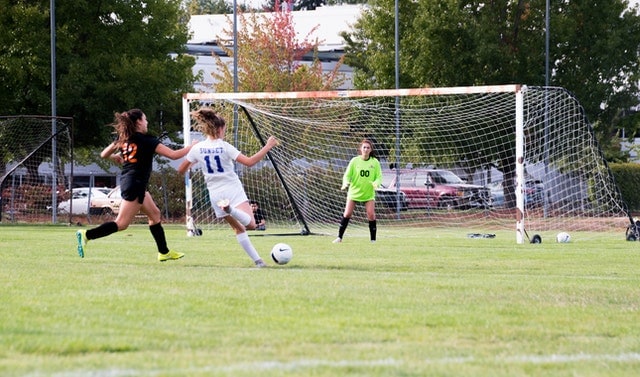
The defender attempting the poke tackle usually uses the tip of their feet to kick the ball away. With that said, the defender who’s performing the poke tackle needs to be extra careful since kicking their opponent instead of kicking the ball can cause them a card from the referee, and can cause an injury to their opponent too.
What are shoulder tackles in soccer?
Shoulder tackles are when a defender uses their shoulder to cover the ball and take it from their opponent.
As mentioned in one of our previous articles using shoulders in soccer is allowed and is an essential part of the game.
Here are the most 2 common ways in which a shoulder tackle is used:
1- When the opponent is moving slowly towards a defender, the defender might attempt to use their shoulder to place themselves between the opponent and the ball, and then take the ball from the opponent.
2- When 2 opponents are running in the same direction close to each other while fighting for the ball, each of these opponents can use their shoulder to slightly push the other player and gain advantage to grab the ball.
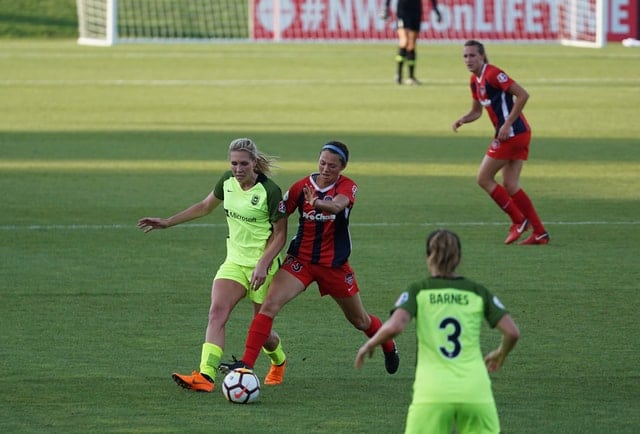
Are soccer tackles dangerous?
Tackles in soccer can sometimes be dangerous and risky for both players involved. If the player who’s performing the tackle hits their opponent instead of hitting the ball, then they might get a card depending on the severity of the hit.
Players who are tackled might sometimes get injured if the tackle was aggressive. Aggressive tackles in soccer are not tolerated by the referees at all and they usually result in a red card.
However, this does not mean that tackles are dangerous all the time. Soccer is a relatively safe sport and most professional soccer players know how to perform a tackle without hurting their opponents.
Most of the tackles performed during a soccer match do not result in any injury or any cards, however, the possibility of someone getting hurt during a tackle in soccer is always there if both of the players involved weren’t careful enough.
What are the skills needed to perform a successful tackle in soccer?
I wanted to end this article with a list of the skills needed from a player to perform a successful tackle.
1- Timing
Timing is everything when it comes to tackling, especially the slide tackles. When a defender decides to tackle their opponent, they need to time their movement perfectly in order to hit the ball.
2- Accuracy
The soccer ball isn’t very large, and the players performing the tackle are supposed to only hit the ball. This means that the player performing the tackle should be extremely accurate with the way they use their legs or else they might accidentally hit their opponent and cause some trouble
3- Determination
Once a soccer player makes up their mind that they want to tackle the ball, they should not hesitate or back up.
If a player decides to revert their tackle attempt, then they might hurt their opponent and even hurt themselves.
So, the moment a player decides to go for a tackle, they should complete their attempt with no hesitation.
With that said, I’ll end my article here. Here’s a quick summary of what you have just read.
Summary
Tackles in soccer are attempts in which soccer players try to grab the ball from their opponents. Tackles are allowed in soccer and they are a core part of the game. The most common soccer tackles are slide tackles, block tackles, poke tackles, and shoulder tackles.
Tackles are usually not dangerous but they can result in injury if neither of the players involved were careful enough.
To perform a tackle in soccer, a player must have accurate timing, accurate control over their feet and they must be 100% determined to finish their tackle once they start it.
Thank you for reading this far, enjoy your next soccer match.

